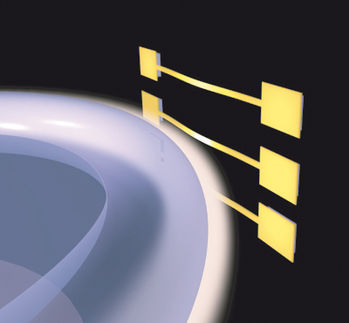Radioactivity: Discover the lowest amounts with new methods
Detecting ever lower amounts of ionising radiation with ever better methods – scientists have had this goal since the start of the nuclear age. In addition to natural radiation, mankind is exposed to a multitude of other sources of radiation which result from the military and technical use of radioactive substances. To protect health, but also for technical and medical applications, it is necessary to determine even the smallest amounts of radionuclides with high precision. On the invitation of the Physikalisch-Technische Bundesanstalt (PTB), scientists from 27 countries are meeting from 22nd to 26th September 2008 to exchange ideas about new measurement and analytical techniques and possible ways of applying them: at the "5th International Conference on Radionuclide metrology Low-Level Radioactivity Measurement Techniques". PTB scientists contribute to this international exchange with three dissertations:
1. The German thoron progeny chamber – Concept and Application
For the measurement of the thoron progenies, a reference field has been established within the scope of a project funded by the Federal Ministry of Environment, Nature Protection Reactor Safety. This field consists of an air-conditioned walk-in testing chamber in which the environmental parameters temperature, air humidity and aerosol content can be adjusted and controlled. Analogue to the radon reference chamber, Carnauba wax aerosol is used as model aerosol. The activity concentrations of thoron and of the thoron progenies shall be adjusted by means of several open exhalation sources with 228Th which are distributed in the chamber. Homogeneity of the environmental parameters and of the activity concentrations of thoron and its progenies in the chamber is ensured by a special ventilation system. With this system, a compromise has been made between high circulation rates due to the low half-life of thoron, on the one hand, and low flow velocities due to the otherwise possible separation of the aerosol particle at surfaces of the chamber, on the other hand. The thoron progenies which mainly accumulate on the aerosol particles, shall be measured analogously by measuring the radon progenies after their separation by means of wire meshes (free fraction) or filters (fraction attached on aerosol partiles) in a follow-up product measuring set-up. By simultaneous spectrometry of the α- and γ-radiation emitted from the sample, quantifying of all thoron progenies as well as traceability of the measurement to the national activity standard is guaranteed.
2. Improvements of low-level gamma-ray Spectrometry Systems at UDO
The Physikalisch-Technische Bundesanstalt (PTB), the German metrology institute, operates various low-background gamma-ray spectrometry systems at the underground laboratory (UDO) in the Asse salt mine, near Braunschweig. The experiences gained with these detector systems within ten years of operation lead to various changes and improvements of the experimental installations. In 2004, the whole UDO facility had to be moved within the Asse mine from its former location at a depth of 925 m to the present depth of 490 m. At its new location, the radon activity concentration in air (about 60 Bq/m3) is by a factor of three higher than at the 925 m level. Therefore, it became necessary to significantly improve the shielding against radon, at least for the most sensitive detector system. This radon shield consist of an almost air-tight box which surrounds the whole passive shielding. In addition, an improved nitrogen flashing of the inner volume of the detector chamber was realized by changes of the design. At the same time, the end-cap of this detector was exchanged with the aim to reduce the inherent background of the system (especially from 40K). The background characteristics achieved with an electrolytic copper end-cap equipped with a thin carbon epoxy entrance window are compared with results obtained after the change to a low-activity aluminum end-cap operated at the same detector.
3. On Monte Carlo Simulation of HPGE Gamma-Spectrometry Systems
A complete calibration of gamma-spectrometry systems cannot be achieved exclusively on the basis of experimental measurements. Comprehensive experimental calibration is especially difficult in the case of low-level measurements, when volume sources, for which a proper standard is unavailable, are measured in close to detector high efficiency configurations, favoring important nuclide specific coincidence-summing effects. In such cases Monte Carlo simulation methods are among the best tools available for complementing experimental calibration.
Most read news
Topics
Organizations
Other news from the department science
These products might interest you

FIBRETHERM by C. Gerhardt
Automatic Fibre Extraction for Feed Analysis
FIBRETHERM from C. Gerhardt: Efficient – Precise – Method-Compliant

Mini-UniPrep™ by Cytiva
Improved HPLC Sample Preparation
Save 66 % sample preparation time and reduce costs by 40 %

Glass and quartz microfiber filter by Cytiva
Request a glass microfiber sample pack to meet your battery development needs
Delivering efficient and consistent results

GF/C and 934-AH RTU (Environmental) by Cytiva
Meet wastewater regulations with the right filter
Streamline lab operations and ensure high-quality results

VICI Jour Katalog 15INT by VICI
The VICI Jour Catalog - Accessories for (U)HPLC and Liquid Handling
Capillaries, Tubing, Fittings, Filters, Safety-Products, Tools and much more

Hahnemühle LifeScience Catalogue Industry & Laboratory by Hahnemühle
Wide variety of Filter Papers for all Laboratory and Industrial Applications
Filtration Solutions in the Life Sciences, Chemical and Pharmaceutical Sectors

Whatman filtration product guide by Cytiva
New filtration catalog - a wealth of information on 286 pages
Discover the perfect filters for your laboratory application

Get the chemical industry in your inbox
From now on, don't miss a thing: Our newsletter for the chemical industry, analytics, lab technology and process engineering brings you up to date every Tuesday and Thursday. The latest industry news, product highlights and innovations - compact and easy to understand in your inbox. Researched by us so you don't have to.








![[Fe]-hydrogenase catalysis visualized using para-hydrogen-enhanced nuclear magnetic resonance spectroscopy](https://img.chemie.de/Portal/News/675fd46b9b54f_sBuG8s4sS.png?tr=w-712,h-534,cm-extract,x-0,y-16:n-xl)















































